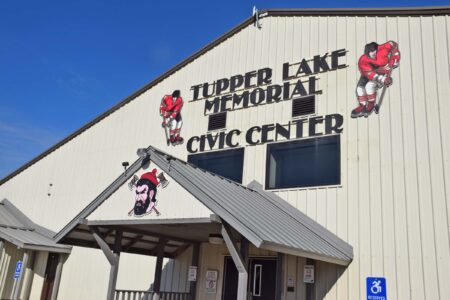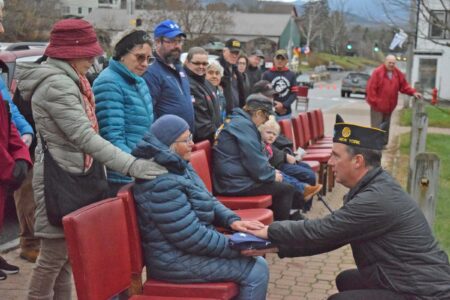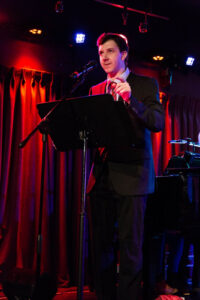Getting proactive about fighting climate change
Symposium looks at national, community and individual levels
- Richard Brandt, science manager at the Atmospheric Sciences Research Center at Whiteface Mountain, presents the latest scientific understanding of climate change at the climate action symposium at First Presbyterian Church in April. (Enterprise photo — Jesse Adcock)
- Above left, Kate Glenn, sustainability coordinator at Paul Smith’s College, presents an overview of the Climate Smart Communities program at the climate action symposium at First Presbyterian Church Sunday. (Enterprise photo — Jesse Adcock)
- Cedar Young, a Saranac Lake High School student and village Climate Smart committee representative talks about the village’s progress at the climate action symposium at the First Presbyterian Church Sunday. (Enterprise photo — Jesse Adcock)

Richard Brandt, science manager at the Atmospheric Sciences Research Center at Whiteface Mountain, presents the latest scientific understanding of climate change at the climate action symposium at First Presbyterian Church in April. (Enterprise photo — Jesse Adcock)
SARANAC LAKE — Around 100 turned out for a climate change symposium at the First Presbyterian Church of Saranac Lake, where the issue was discussed at the national, community and individual levels.
Titled “Climate Action: What are we doing about climate change?,” the symposium was organized by Adirondack Voters for Change, and co-sponsored by the Citizens’ Climate Lobby, Paul Smith’s College, First Presbyterian Church of Saranac Lake and TriLakes350.org.
“I wanted to focus on the action part,” said event organizer Ellen Beberman, committee chair of Adirondack Voters for Change. “For anything to change, it has to go from top to bottom. The whole society has to change. .. so the focuses went national, state, local, individual.
—
National Level

Above left, Kate Glenn, sustainability coordinator at Paul Smith’s College, presents an overview of the Climate Smart Communities program at the climate action symposium at First Presbyterian Church Sunday. (Enterprise photo — Jesse Adcock)
First to present was Richard Brandt, a research meteorologist from the University of Washington and current manager of SUNY Albany’s Whiteface Mountain Field Station, monitoring air quality.
“We just recently have developed a collaboration with Rochester and Harvard and SUNY Plattsburgh, and have a remarkable instrument that’s measuring the CO2 every few seconds, as well as the methane,” Brandt said, of the field station.
He said they’ve recorded a CO2 level increase from 350 to 420 ppm in recent history, and have been detecting increases in methane as well, from fracking in Pennsylvania. These greenhouse gas buildups cause hotter temperatures, faster ice melt in the world’s polar regions and rising sea levels.
“I wish I could tell more positive stories, but this is the story of climate,” Brandt said. “From the science perspective, what I’m trying to say is time is of the essence.
Next, Paul Smith’s College professor Joe Henderson, Ph.D., presented on the social dynamics of climate change, and the Green New Deal.

Cedar Young, a Saranac Lake High School student and village Climate Smart committee representative talks about the village’s progress at the climate action symposium at the First Presbyterian Church Sunday. (Enterprise photo — Jesse Adcock)
“Younger Americans are more worried than older Americans, which makes sense, given that they are the ones that are going to suffer the most from this,” Henderson said.
There is good news: the American people are very slowly moving toward acceptance, according to the Yale Program on Climate Change Communication.
“Gradually, people are accepting it in the United States,” Henderson said. “Doubt around the science has been diminished.”
Henderson said Millennials are most likely to identify climate change as a problem — even Millennial Republicans.
“There’s a generational thing,” Henderson said. “We are the only advanced country in the world that has one political party that denies the science of climate change.”
Cathy Brown, a volunteer with the North Country chapter of the Citizens’ Climate Lobby, presented on the Carbon Dividend Act. It’s a bipartisan piece of legislation that would add a carbon tax onto industries that use fossil fuels, to drive the market toward renewable energy sources.
“At this late stage, I don’t think any one bill is going to be enough. We’re going to need a number of tools and I think this is a really important one,” Brown said.
—
Community level
At the community level, municipalities have the option of working with the New York State Energy Research and Development Authority to be designated Clean Energy Communities.
Kate Glenn, sustainability coordinator at Paul Smith’s College, laid out the basics of the program — with the state offering incentives, like matching grant funding, for communities that work to reduce their carbon footprint.
“It’s a toolkit that the state was able to create,” said Patrick Murphy, village trustee and member of the village Climate Smart Committee. “We can pick and choose exactly what’s going to work best for Saranac Lake.”
Next, Emmet Smith, co-founder of Northern Power and Light, explained the benefits of supporting local renewable power generators.
“My thesis here to today is talk about electricity choices,” Smith said. “There’s a lot of opportunities for people in the North Country to be able to choose a renewable electricity supply. And it’s one of the simpler things we can all do to mitigate our carbon footprint.”
Typically, when a customer pays the utility for their electricity, they might be paying 15 cents per kilowatt hour.
“Your local powerplant gets 1.5 cents,” Smith said. “You can’t build a new solar array on 1.5 cents, even with state subsidies.”
But through community distributed generation, a new power supply option by the state, a customer can buy a share in a local renewable generator in return for a credit on their utility bill.
“It actually results in a much higher rate for electricity going to the generator,” Smith said.
This means a community can preserve existing assets, like old hydro-electric generators, localize the value of electricity and localize the ownership of renewable generators.
“By localizing the value, ultimately that economic power gives you the ability to localize control,” he said.
—
Individual
Betsy Brooks, head of technical services and automation with the Clinton, Essex and Franklin Library system presented on the “Drawdown” project, which compiled 100 strategies for reversing global warming. Strategies range from city planning, to the individual behaviors to reduce human impact on the environment.
Top solutions included practicing a plant-rich diet, reducing food waste, preserving tropical forests and building offshore wind turbines and rooftop solar panels.
The Rev. Joann White, pastor at First Presbyterian Church of Saranac Lake, presented on faith and climate change. She recounted being in theological seminary, and asking a professor what God created the earth from. White said the professor replied that God used his own self, and therefore, all of creation is sacred. She outlined some of the efforts her congregation has undertaken, from hikes to renovating the building to be more energy efficient.
Beberman said the symposium was not a one time thing, and that Adirondack Voters for Change plans to organize more climate-related community events, like a panel discussion with North Country politicians.







